
Original Author: Trend Research
Since ETH entered this round of bullish cycle, every short-term fluctuation adjustment has led the market to start spreading data on ETH unstaking. However, from the perspective of supply and demand, the demand generated by institutional consensus currently far exceeds the supply from unstaking, and we believe that the long-term full capacity of unstaking is not sustainable. Since treasury companies represented by SharpLink began buying, U.S. companies holding ETH have accumulated nearly $20 billion in ETH, accounting for 3.39% of the total supply, with Bitmine still having 75% progress to reach its target of holding 5% of ETH. With the further implementation of crypto-friendly policies and Wall Street's consensus on the long-term value of ETH, the "rush" for ETH has just begun. As the interest rate cut cycle approaches, we are raising our long-term target price for ETH, believing that ETH's market capitalization will surpass BTC in 1-2 bull-bear cycles.
1. Unstaking Data
Since the Ethereum Pectra (Prague+Electra) mainnet upgrade took effect in May 2025, the theoretical unstaking rate has been capped at 256 ETH/epoch (1 epoch ≈ 6.4 minutes). This translates to a daily theoretical limit of 256 × (1440 ÷ 6.4) = 256 × 225 = 57,600 ETH/day.
Since July 18, the unstaking situation on the ETH mainnet has been in a full queue state, with currently (as of August 24) 873,849 ETH waiting to be unstaked, requiring 15 days and 4 hours to process.
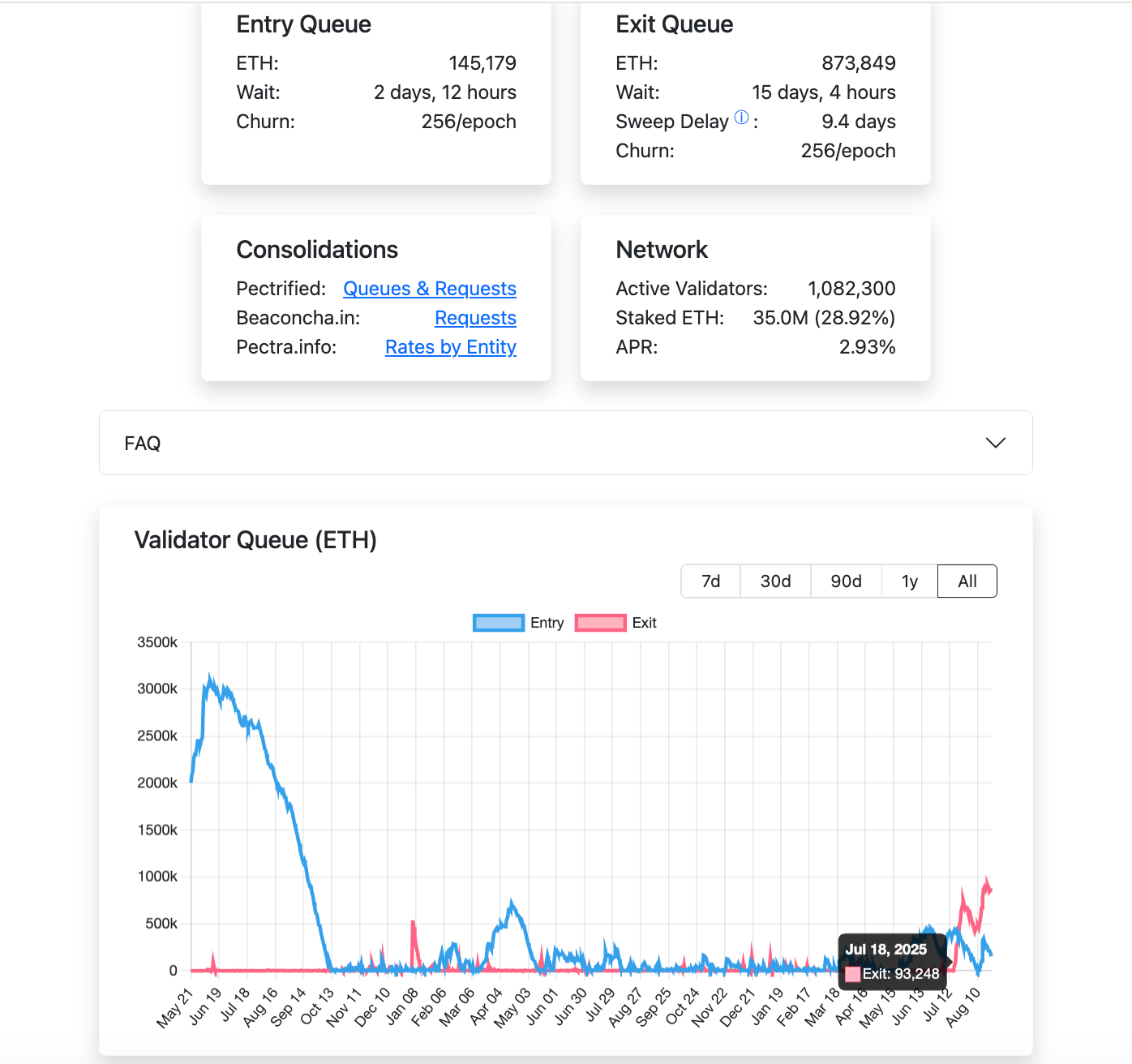
The weekly unstaking limit for ETH is capped at 57,600 × 7 = 403,200 ETH, while last week treasury companies bought 531,400 ETH. Even if 100% of the unstaked portion enters circulation, it can be fully absorbed under the condition that treasury companies continue to buy. We believe that the current network value of ETH has not been fully recognized by the market, and the unstaked ETH does not fully enter circulation. As consensus further forms, the full capacity of unstaking will also improve.
In simple terms, unstaking does not represent the complete market supply situation. Although the total amount of unstaked ETH shows a certain negative correlation with the rising ETH price, we believe that this portion of supply will not dominate ETH's transition from rising to falling markets.
2. Demand Analysis of Treasury Companies and ETFs
Since June 2025, treasury companies represented by SharpLink have entered the market, confirming our previous speculation that the U.S. would prioritize ETH as the primary battleground for financial on-chain infrastructure (see our reports published on June 11 and July 3 titled "Why We Are Optimistic About ETH Before the Surge" and "The Market Forces Will Drive ETH to Realize Value Discovery"). The entry of institutional buying power represented by treasury companies fundamentally changes the dominant force behind ETH price fluctuations.

1. The Operating Logic of Treasury Companies - Accumulating Coins Leads to Premium
The market premium (MNAV) of cryptocurrency treasury companies comes from investors' recognition of the growth potential of their purchased assets. DAT companies increase their crypto asset holdings through financing (stock issuance or debt), creating a flywheel effect: more crypto assets → balance sheet expansion → stock price increase → more financing capacity → further accumulation. This cycle amplifies the market's optimistic expectations for coin-holding stocks, driving MNAV premiums. This flywheel effect is evidenced by the success of MicroStrategy, and ETH has some characteristics that make it more suitable as treasury assets compared to BTC.
2. What Makes ETH Treasury Companies Different - Assets Generate Income
Unlike the limited assets of BTC that rely on scarcity for purchase, ETH, as the largest DeFi network in the crypto world, will naturally generate income through large-scale holdings.
(1) Staking Income: Since Ethereum transitioned to a PoS mechanism after the "Merge" in 2022, ETH has been endowed with income-generating asset properties, while its ecosystem supports high-yield activities such as DeFi and RWA. These characteristics provide DAT with a stable cash flow source, forming the basis for "cash flow premium." As of August 2025, the total amount of staked Ethereum reached 36 million ETH, accounting for 30% of the total supply, with an average annualized yield of about 2.95% (actual yield around 1.5%-2.15%). A 1.5% risk-free return is similar to the cash flow of traditional bonds.
(2) Liquidity Income: Additional income can be obtained by providing liquidity through DeFi protocols in the Ethereum ecosystem. In 2025, the total value locked (TVL) in Ethereum DeFi protocols was approximately $120 billion, with annualized yields from liquidity mining typically ranging between 2-10%. Assuming that coin-holding stocks provide liquidity through DeFi protocols, a conservative estimate would yield an annualized return of 3.5%. Combining staking income (1.5%) and liquidity income (3.5%), coin-holding stocks could achieve approximately 5% annualized cash flow returns. Using a discounted cash flow (DCF) model, assuming a discount rate of 5%, the cash flow premium would be 1 times MNAV, resulting in a total MNAV multiple of 2 times.
(3) Other Premiums: Ethereum's EIP-1559 mechanism creates potential deflationary characteristics by burning base transaction fees. In 2025, Ethereum is expected to have a net issuance of 730,000 ETH (annual inflation rate of about 0.6%), but with network burns. If ETH achieves net deflation in the future, its price may only rise, amplifying the cash flow returns of coin-holding stocks and indirectly enhancing MNAV premiums.
3. The Buying Power of Treasury Companies Has Just Begun
The ETH treasury companies BMNR and SBET have high buying costs and ample backhand, while the overall buying power of traditional finance is still in the startup phase. According to data summarized by Yu Jin, BitMine (BMNR) has reserved 1,523,373 ETH since July 9, with a cost of $5.68 billion and an average price of $3,730 per ETH, while SharpLink (SBET) has reserved 740,760 ETH since June 13, with a cost of $2.57 billion and an average price of $3,478 per ETH, including 1,388 ETH rewards obtained through staking. As Ethereum prices continue to rise, the holding costs for both companies will also increase.

From the perspective of future financing capabilities:
BMNR: According to the Prospectus Supplement released on August 12, 2025, BMNR has raised its total ATM amount to $24.5 billion, and it is expected to have cumulatively financed about $4.45 billion through the ATM mechanism, holding approximately 1.52 million ETH. Theoretically, there is still about $18-20 billion available. If ETH is priced at $4,700 per coin, BMNR could potentially increase its holdings by about 4.26 million ETH, bringing its potential total holding limit close to 5.78 million ETH, nearing the target of holding 5% of the total.
SBET: Since SharpLink launched its ETH treasury strategy in June 2025, it has rapidly accumulated about 740,760 ETH through ATM financing (approximately $1.2 billion) and registered direct sales. Its ATM limit has been adjusted from the initial amount to a maximum of $6 billion, and it is expected to obtain about $600 million through targeted issuance. Assuming all financing is used to purchase ETH, based on ETH costs, the remaining ATM balance is expected to purchase 851,000 ETH.
Currently, U.S. companies holding ETH have accumulated nearly $20 billion in ETH, accounting for 3.39% of the total supply, with Bitmine still having 75% progress to reach its target of holding 5% of ETH.
Daily ATM funding:
MicroStrategy is a representative of the Bitcoin treasury strategy, with its trading volume significantly varying between bull and bear markets.
MicroStrategy implemented its Bitcoin treasury strategy in 2020, and during the 2020-2021 bull market, its stock price rose from $13 to a peak of $540, with daily trading volume increasing significantly, but it is heavily influenced by market activity and BTC prices. Based on recent stock prices and average trading volume, the daily trading volume is estimated to be around $3.5 billion to $7 billion.
During the bear market in 2022, Bitcoin's price plummeted from $69,000 to $16,000, leading to a halving of MicroStrategy's stock price and a significant shrinkage in trading volume, with daily trading volume dropping to $200 million to $500 million.
Comparing to ETH DAT companies, a similar situation may arise:
BitMine's current trading volume has reached $2 billion daily, peaking at $6 billion, nearing or exceeding MicroStrategy's peak in the last bull market, receiving high market attention. Meanwhile, SBET's daily trading volume fluctuates significantly, averaging 50 million shares, with daily trading volume around $1 billion. If the market enters a bear phase, DAT companies' trading volume may shrink to $100 million to $500 million daily, similar to MicroStrategy's performance in 2022. Assuming 10%-20% of daily trading volume can be converted to ATM, under the current trading volume, it could raise $2 billion to $4 billion weekly for purchasing ETH, expected to last for 3 months based on ATM limits.
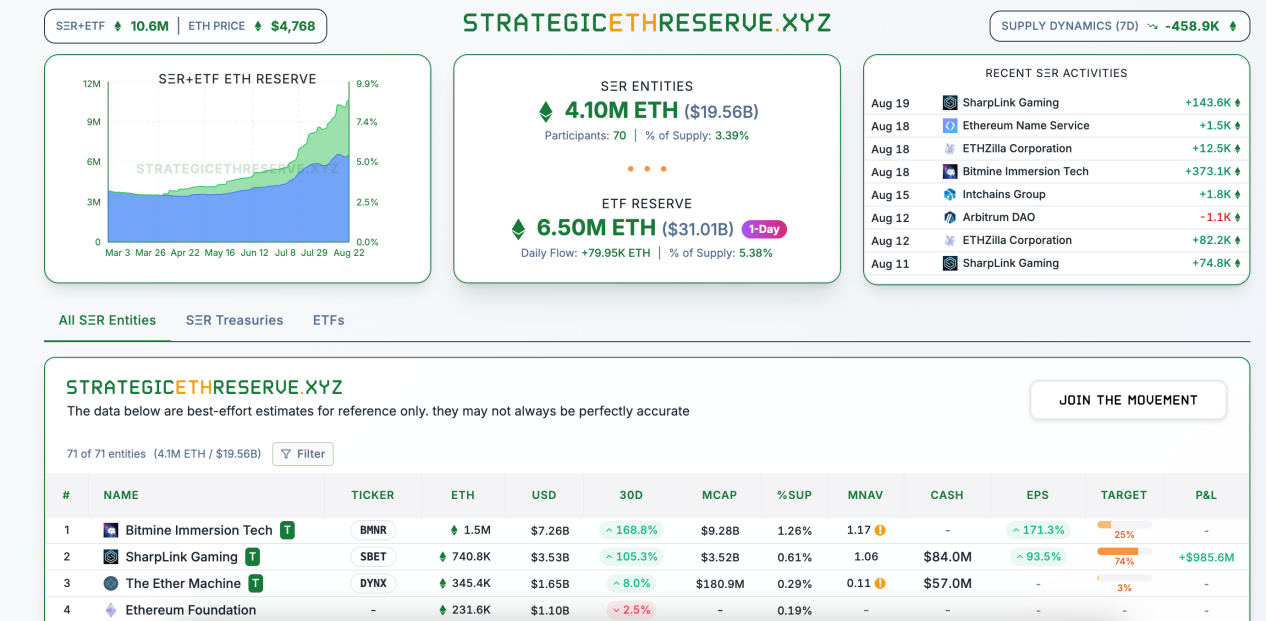
4. The Long-Term Performance of ETFs Remains Strong
ETF, as a passive fund that achieves success through large-scale and low-cost acquisition, has become the preferred choice for traditional large-scale capital allocation. From May 16 to August 15, ETH ETFs recorded 14 consecutive weeks of net inflows, with a maximum single-week net inflow of $2.85 billion, and the net asset value accounted for 5.38% of the total supply. Among this, $19.2 billion worth (68%) of ETH was accumulated over the 14 weeks, with an estimated average buying cost of around $3,600.
BlackRock's ETHA is the largest ETF, holding approximately 2.93% of the tokens, with a current market value of $17.2 billion. Since April 2025, ETHA has been in a state of net inflow every week, with net inflow funds of about $8 billion and a maximum single-week net inflow of $2.32 billion.
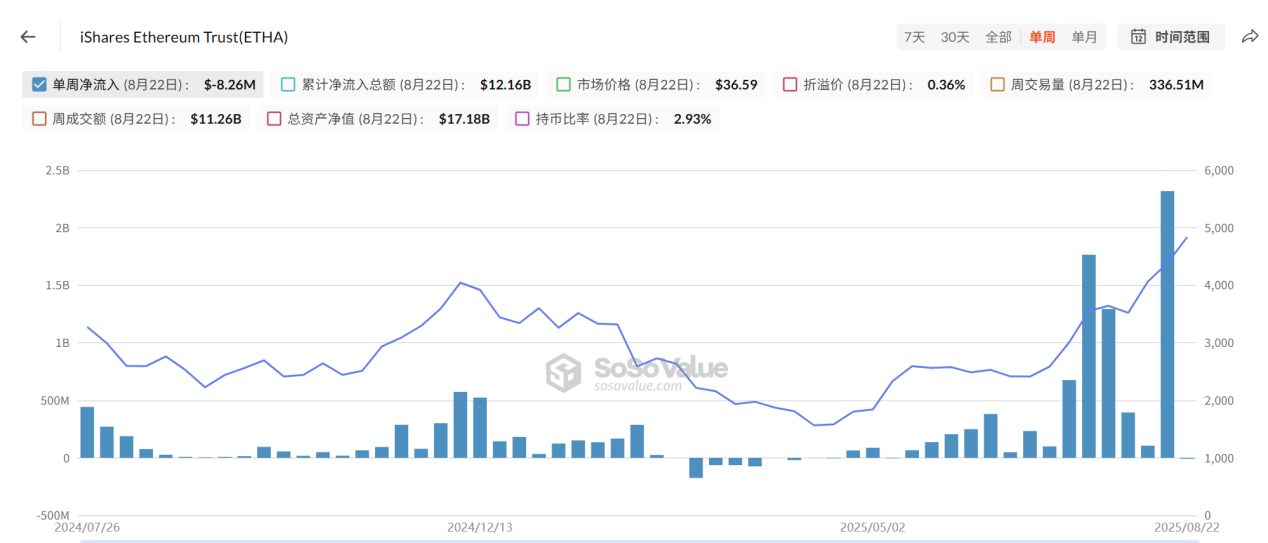
Currently, the global gold ETF (aggregating ETFs/ETPs worldwide) has a scale of $386 billion, Bitcoin at $179.5 billion, while Ethereum is only at $32.6 billion. If the Ethereum narrative is sustainable, it would require an increase of $140 billion to catch up with the current Bitcoin ETF scale.
5. Market Risk Appetite Shifts from BTC to ETH Trading
From the perspective of contract open interest and trading volume, BTC has clearly cooled down, with funds concentrating into ETH. At the beginning of May, BTC contract open interest accounted for 73%, and now it is only 55%; the open interest for ETH has risen from 27% to 45%.
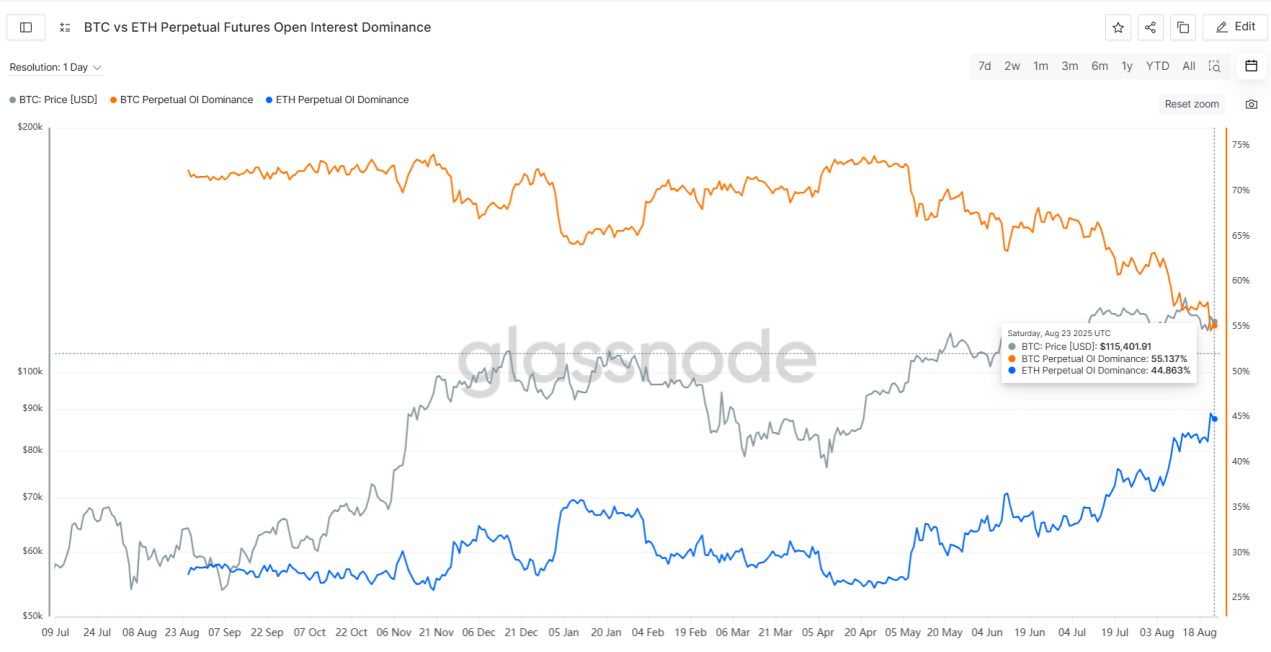
In terms of contract trading volume, BTC's trading volume share has decreased from 61% at the beginning of May to the current 31%; ETH's trading volume share has increased from 35% at the beginning of May to the current 68%, with the share continuing to rise.
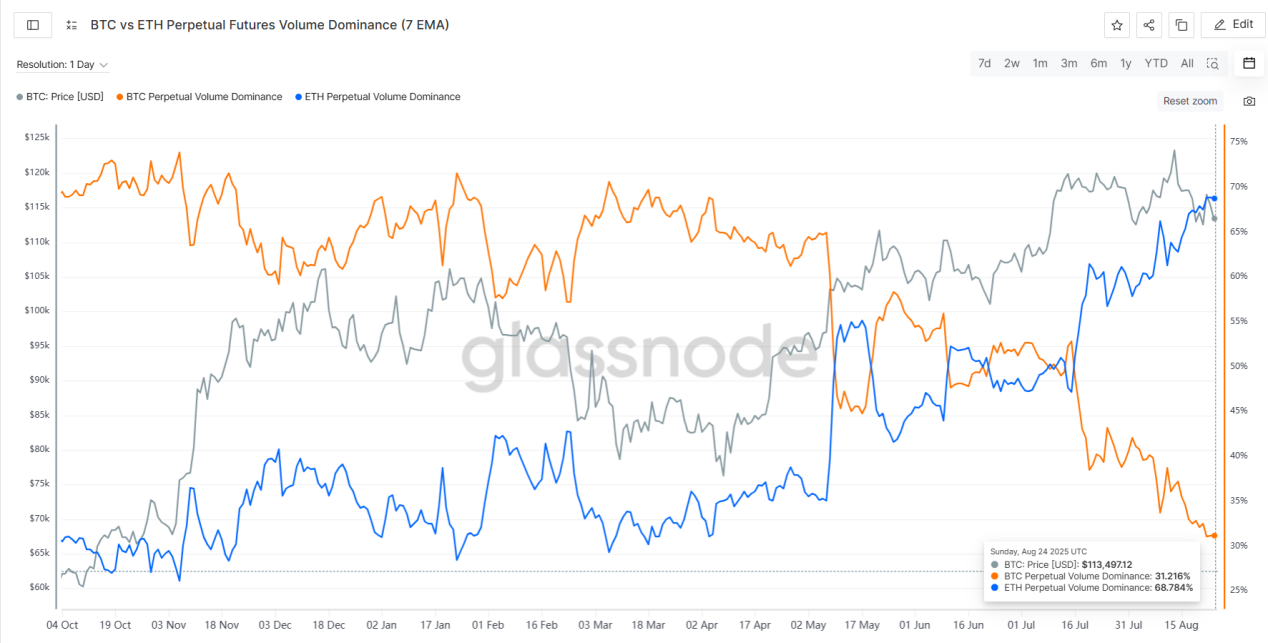
Recent behavior of on-chain whales indicates a shift in risk appetite from selling BTC to buying ETH. According to @ai_9684 xtpa data, starting from August 20, an ancient BTC whale that had been dormant for 7 years sold part of its BTC, swapping for 71,108 ETH (worth about $304 million) at an average cost of about $4,284/ETH. The total holding later increased to 105,599 ETH (worth about $495 million). At the same time, it built long positions in ETH on Hyperliquid and staked 269,485 ETH (worth $1.25 billion) to the ETH beacon chain on August 25, directly surpassing the Ethereum Foundation's holdings (231,000 ETH).
During Q2 2025, on-chain Ethereum whales (wallets holding 10,000 to 100,000 ETH) increased their holdings by 200,000 ETH (worth $515 million), while super whales (holding over 100,000 ETH) saw their total ETH holdings rise from a historical low of 37.56 million ETH in October 2024 to over 41.06 million ETH, an increase of 9.31% since October 2024.
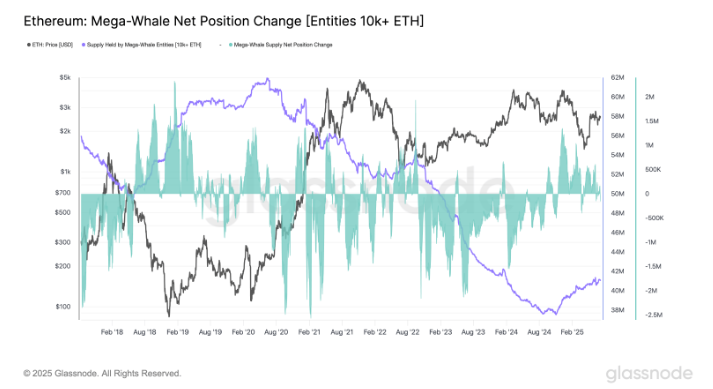
3. BTC Chip Structure Remains Relatively Stable
Due to the shift in risk appetite from BTC to ETH, BTC has recently shown relatively weak performance. From the ETF perspective, there has been a significant net outflow; from the on-chain whale perspective, many whales are swapping BTC for ETH. Based on past experiences from the four-year cycle in the crypto space, this bull market is expected to reach a duration comparable to previous bull markets in another 2-3 months. Therefore, there are concerns in the market: Is BTC about to enter a bear market? If BTC enters a bear market, how can ETH remain independent and achieve an upward trend?
We believe that the current U.S. fiscal cycle is longer than in the previous two crypto bull markets, while BTC's chip structure remains relatively stable, currently in a state of fluctuation.

The following chart illustrates the distribution of BTC chip costs, with the gray bars representing the current price, and the blue boxes indicating the main concentration areas of chips, which are 93K-98K, 103K-108K, and 116K-118K. The accumulated chip volume in these three areas is substantial, with a large amount of low-cost chips changing hands in this range, thus forming relatively strong support.
Currently, the chips in the 116K-118K range are in a state of slight loss, while the chips in the 93K-98K and 103K-108K ranges are in profit. Although BTC's price performance is relatively weak, it has found support near 11K, with two significant support areas below, overall remaining in a state of fluctuation.
Additionally, the current cost basis for short-term holders is approximately 108,800. When BTC operates above this level, short-term holders remain in profit overall and are unlikely to panic sell. Historically, there have been two instances in early 2024 where rebounds occurred near the short-term holder cost line, as well as a situation in February 2025 where the price fell below this cost line upon first touching it. If it falls below this cost line, BTC will enter a mid-term adjustment, affecting the overall trend of the crypto industry.
Currently, BTC is at a critical position, having rebounded after touching this cost line yesterday. This week, close attention should be paid to whether BTC can stabilize at this position.
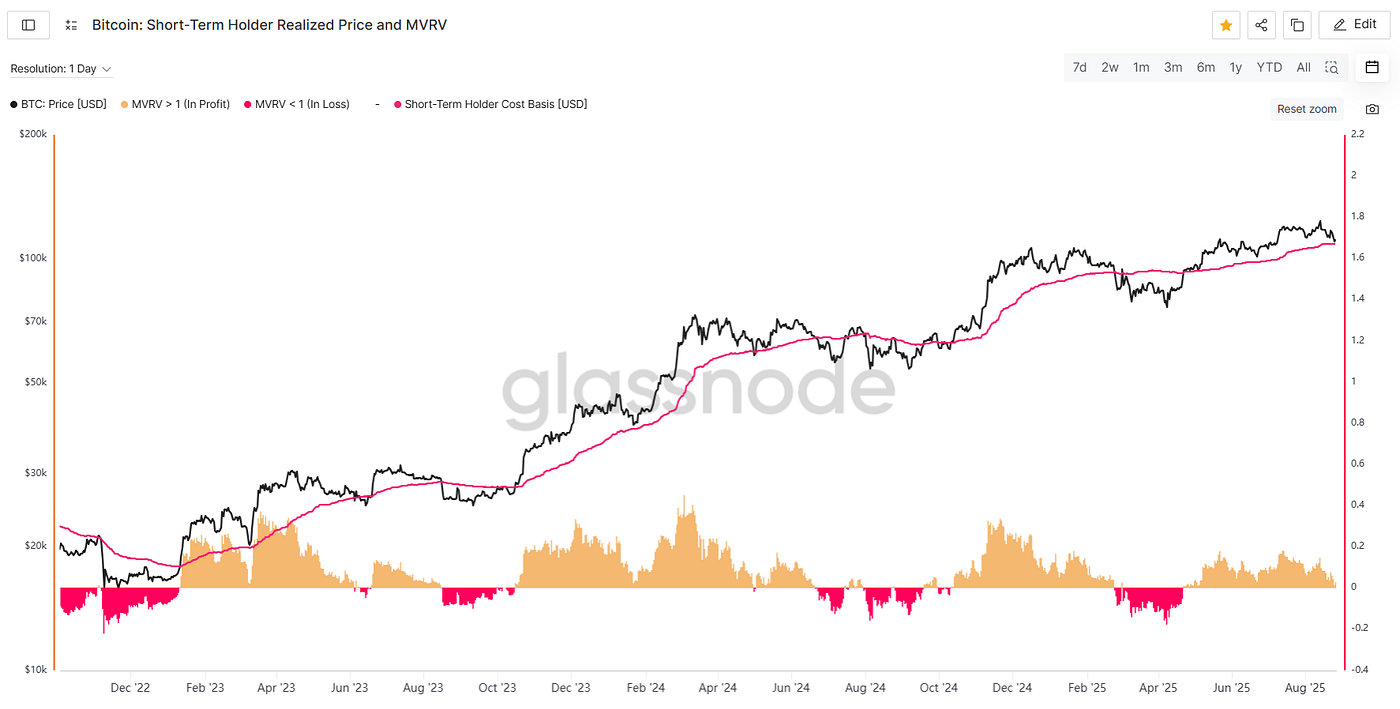
4. Continuously Improving Macroeconomic Environment
1. Fundamental Valuation Logic Restructured Under U.S. Regulations
In July 2025, the U.S. GENIUS stablecoin bill was officially legislated. Compared to BTC, stablecoins are pegged 1:1 to the U.S. dollar, and their higher capital efficiency makes them more suitable as debt reduction tools. At the same time, stablecoins can drive global capital to flow efficiently into the U.S. dollar system, supporting U.S. Treasury purchases and injecting liquidity into on-chain financial assets, promoting the digital expansion of U.S. dollar hegemony. Currently, the total market value of stablecoins is $275 billion, while BTC's market value is $2.2 trillion, with the estimated global mining machine value for BTC at $15-20 billion, ETH's market value at $550 billion, and staking value at about $165 billion. In the future, whether replacing BTC's partial debt reduction function, promoting the coverage of asset on-chain value, or accommodating new payment systems, the scale of stablecoins will accelerate expansion in the long term, rapidly growing to a multi-trillion dollar market size.
As the main infrastructure for stablecoins and DeFi, ETH's price benefits from ETH purchases driven by network security for financial on-chainization, and will also benefit from the endogenous DeFi model: stablecoin injections provide base liquidity - the DeFi ecosystem uses stablecoins to create leverage and derivatives to purchase more ETH - surging trading activity drives gas fees and promotes ETH burning. By using transaction fees (gas fees) and proof of stake (PoS) as cash flow income from the ETH network, a rough valuation calculation using a discounted cash flow (DCF) model under optimistic conditions (7% growth rate, 9% discount rate, leverage factor 3) suggests that ETH's market value has the potential to exceed $3 trillion, surpassing the current market value of BTC.
2. The Interest Rate Cut Cycle is Approaching
On August 22, Powell delivered a speech at the Jackson Hole conference, stating that inflation remains high, but the downside risks to employment are increasing; against the backdrop of policies still in a "restrictive" range, the committee will "proceed cautiously" and will adjust policy positions if necessary. Analysts generally believe that a rate cut in September is almost "a foregone conclusion," representing a turning point towards a dovish shift. Following the speech, crypto-related stocks and ETH-related assets surged, with ETH recovering all its losses from earlier in the week, reaching a historical high of $4,887.
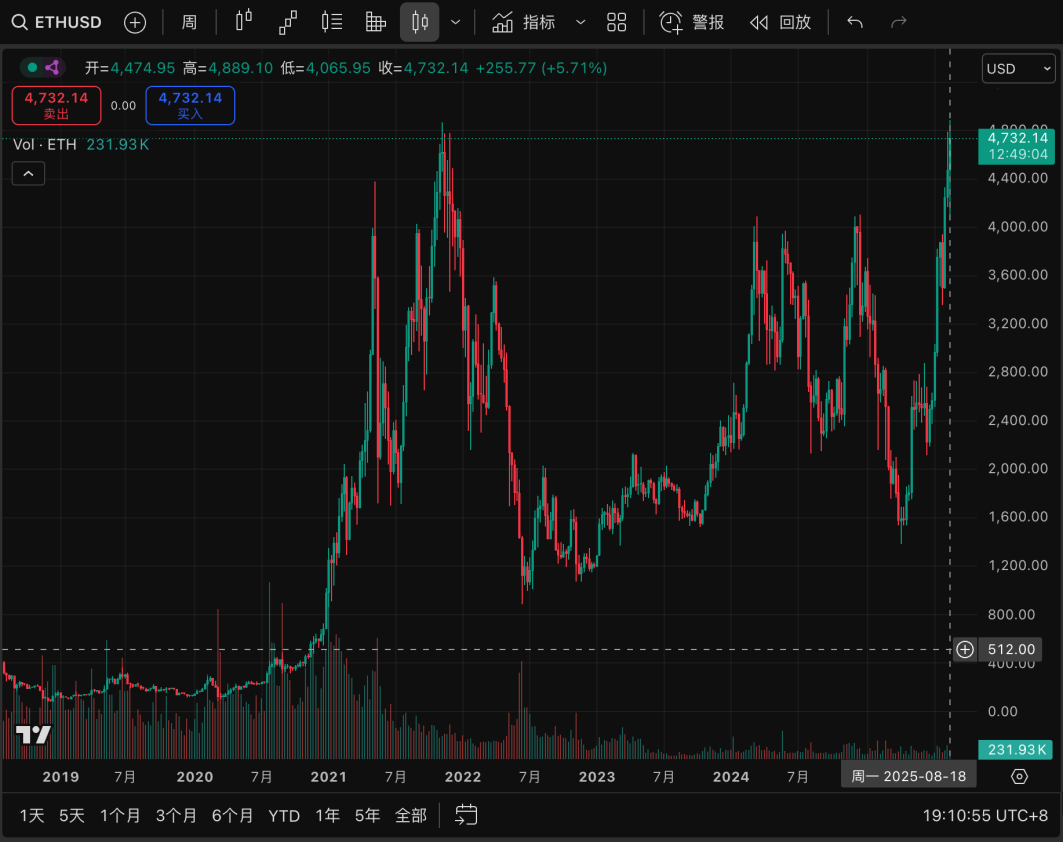
In past interest rate cut cycles, ETH has generally outperformed BTC. With Congress returning from recess in September, the push for crypto policies will accelerate, and the expectations for ETH's financial on-chainization and DeFi prosperity have yet to materialize, providing a positive macro environment for ETH's market.
3. The Preferred Choice for Stablecoin and RWA Development
The U.S. government and financial institutions are consistently promoting the on-chain financial agenda. Currently, the scale of stablecoins has reached $275 billion, and the scale of RWA is $26.4 billion, with over 50% of stablecoins operating on the Ethereum network, and RWA accounting for 53.4% on Ethereum. Over 161.6% of DeFi's total TVL is deployed on ETH. BlackRock's BUIDL fund has 95% deployed on Ethereum, and 80% of Securitize's tokenized shares are deployed on Ethereum.
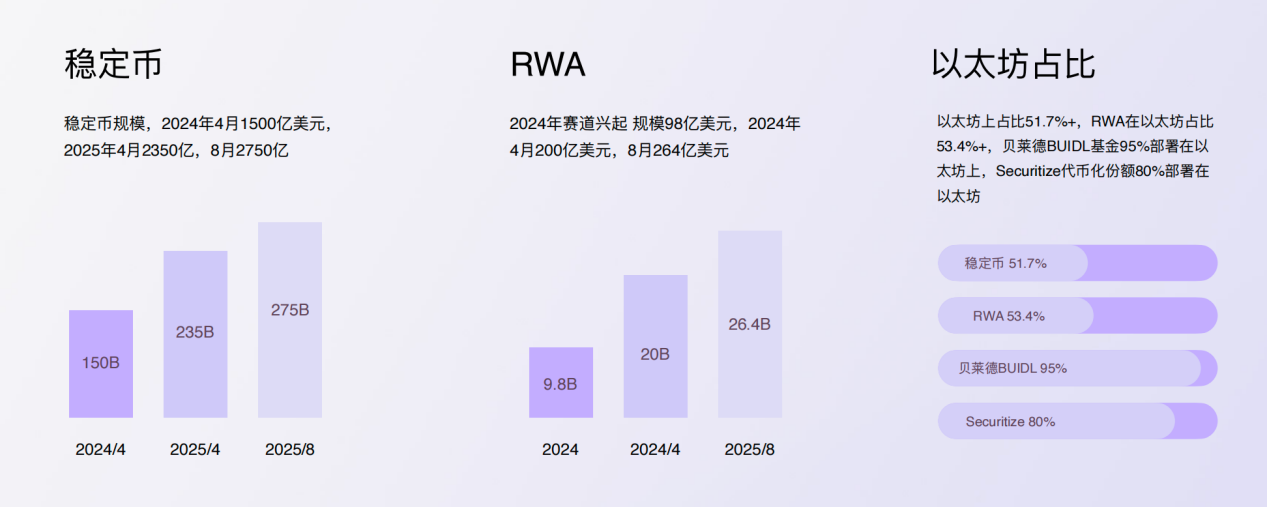
In this article, we have tracked and analyzed some quantitatively clear and large-scale data. Overall, the recent supply-side unstaking data will not change the upward trend of ETH, and the foreseeable upper limit of new buying from the demand side, whether from treasury companies or ETFs, has yet to be reached, with high entry costs. With the fundamental shift in financial logic under U.S. regulations, ETH is an asset that combines internal and external growth to jointly drive price increases. As the macro environment improves and policies develop further, the long-term market value of ETH will surpass BTC.
免责声明:本文章仅代表作者个人观点,不代表本平台的立场和观点。本文章仅供信息分享,不构成对任何人的任何投资建议。用户与作者之间的任何争议,与本平台无关。如网页中刊载的文章或图片涉及侵权,请提供相关的权利证明和身份证明发送邮件到support@aicoin.com,本平台相关工作人员将会进行核查。




